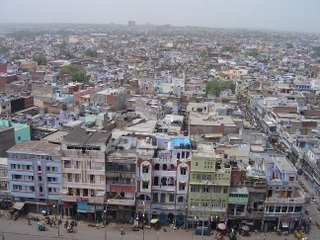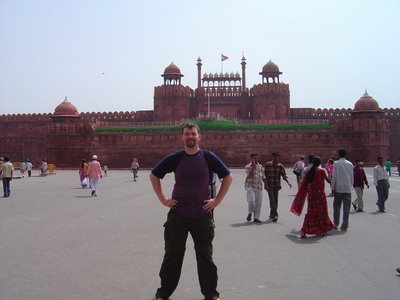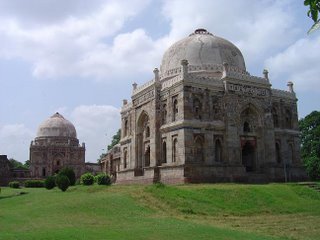You're Looking Swell, Delhi. We Can Tell, Delhi.
Delhi has over 16 million people in the city proper, and nearly 20 million in the immediate area. And those are figures over a year old. In case you were in doubt, that's a lot of folk. Here's a view
 of the town taken from one of the spires of Jama Masjid, the oldest and largest mosque in Old Delhi. I'm about ten or fifteen stories up here (quite a climb in a narrow, twisty spiral stair). I love this shot because the haze in the distance captures what is actually the case- the buildings quite literally stretch as far as the eye can see.
of the town taken from one of the spires of Jama Masjid, the oldest and largest mosque in Old Delhi. I'm about ten or fifteen stories up here (quite a climb in a narrow, twisty spiral stair). I love this shot because the haze in the distance captures what is actually the case- the buildings quite literally stretch as far as the eye can see.The hugeness of the place is tough to exaggerate. There are only a few pockets of skyscrapers (all in New or central Delhi) mostly it's five to six story buildings like you see here. The thing is, they just never end. There's a little greenery tucked into the corners, but on the whole the place is kind of grey and drab. The street level is always lively and colorful, though, given a preference for bright signage and Indian women's love of vibrant traditional clothing. Almost all Indian women wear sarees or similar dress, but ninety percent of the men dress Western. Most of the women who are in Western garb are young girls and women in jeans, or wearing some type of uniform.
There is a lot of activity going on in the street. At times it reminded me of those moments in musicals when the stereotypical busy street scene is rendered with newsboys and fedora'd businessmen walking at rapid pace back and forth across the stage, pumping their arms. Traffic is far more chaotic than elsewhere in Asia, there's none of the lovely zen-like flow to the bodies in motion that I saw in Vietnam. There, you felt confident that accidents were exceedingly rare, here you wonder why you haven't been in a half dozen every minute.
"Old Delhi" refers to the ancient city to the North, while "New Delhi" is the country's current capital, a few kilometers to the south. Central Delhi between the two is dominated by an area called "Connaught Circus" where I stayed. Much like the French architecture in Vietnam and Cambodia, I find the English placenames in India charming. If you think about the centuries of colonialism and oppression, the charm wears off fast, but otherwise it somehow makes the place more exotic.
I started my tour of Delhi at the old Red Fort, built by the same Shah Jehan who erected the Taj Mahal in memory of his wife. Ironically, the fort became the Shah's prison when his son deposed him and kept him there. Every power to rule India since then has made use of the
 massive fort, including the Mughals, the Hindu kings, and the British. It's over two kilometers in length and the walls are thirty meters tall. Those stats are kind of cold and hard to get a grasp of, but let me just assure you it's huuuge.
massive fort, including the Mughals, the Hindu kings, and the British. It's over two kilometers in length and the walls are thirty meters tall. Those stats are kind of cold and hard to get a grasp of, but let me just assure you it's huuuge.
The consistency of the red sandstone has an impressive effect; somehow the place seems grander still just because of the color. Here's a picture of the southern gate, again taken from high atop the nearby mosque spire. The towers and walls of the fort are magnificent, and there's great architecture on the inside too:

By far the most beautiful part of Delhi was the Lodi Gardens. In India the larger public parks seem to
 be often built around ruins or ancient tombs, and Lodi is one of the best examples of this. The gardens were vast and beautiful, full of neatly manicured spaces and also wilder, broad sections of trees and grass. There was a tiny bonsai garden with a hundred little trees in pots, and also a wonderful garden restaurant, where on one hot afternoon I indulged in a fancy western lunch, with the best vichyssoise I'd ever had. Just the thing on a steamy Delhi afternoon, but I still felt guilty- there were only so many days when one can eat Indian food in India.
be often built around ruins or ancient tombs, and Lodi is one of the best examples of this. The gardens were vast and beautiful, full of neatly manicured spaces and also wilder, broad sections of trees and grass. There was a tiny bonsai garden with a hundred little trees in pots, and also a wonderful garden restaurant, where on one hot afternoon I indulged in a fancy western lunch, with the best vichyssoise I'd ever had. Just the thing on a steamy Delhi afternoon, but I still felt guilty- there were only so many days when one can eat Indian food in India.
Next up was the museum and mausoleum of the Mahatma, the highlight of my time in India. The Ben Kingsly film of his life played on television a hundred times when I was ten or eleven, and it had a big impact on me. I think the film had so many ideas and images that had never occurred to me before, and it was also the dawning of my appreciation of acting- Kingsly really convinced me he was this guy. I watched it again a year or two ago for the first time in twenty years and I was amazed at how many moments of the film had stayed etched in my memory.
But this was reality, not cinema. As I stood there, it occurred to me that if anyone could lay claim to the title of the 20th century's greatest man, the diminutive attorney interred under this slab of granite is probably the safest bet. Like many of the other pilgrims, I bought a plate of flower petals and tossed them over the white marble railing. It sounds corny but it felt so good to do that.
I've lately revised my opinions of heroes, and I've decided that they can in fact be good things, for the same reason that a compass point is good when you're navigating. If they have human flaws we should not allow that to degrade the magnitude of their accomplishments. Here, I'm pleased to say, was my hero.
The place and the frame of mind coincide perfectly. When you're standing in the middle of this beautiful sunken courtyard staring at the flickering flame behind the grave, you feel vindicated; it is safe to believe in some things and some people without reservation (perhaps Ghandiji is the great antidote to the postmodern condition). Of course beautiful tombs can be erected for bad men, too, but here it felt so comfortable, so good to slide into a quiet admiration and gratitude for the gift he gave the world: the knowledge that empires with all their injustices can in fact be brought to their knees without firing a shot or raising a fist. It felt so relaxing and wholesome... the moral equivalent of climbing into a warm bath. When Ghandi was assassinated, Einstein said "Generations to come, it may be, will scarce believe that one such as this ever in flesh and blood walked the face of the earth." The Indians are to be commended, for the tomb and accompanying museum are making a strong effort to see that he is remembered as he should.

My last major stop in the city (I'm leaving out some of the other temples and tombs that I saw, though they were all impressive) was Qutb Minar. This magnificent brick minaret on the outskirts of the city cannot, unfortunately, be climbed. It's nonetheless a great example of early Mughal architecture, celebrating their defeat of the Hindu kingdom of Delhi in 1193. Although perhaps climbing a thousand year old tower isn't the swiftest idea after all.
That evening I boarded an overnight train to Varanasi, one of the holiest places for Hindus, seated on the right bank of the Ganges. The train ride was great- I boarded my car around 6:30, found my way to my berth and stowed my luggage on the top bunk. I shared a six-person cabin with three other businessmen in their forties, and I couldn't help thinking the whole time how funny the world is, that something which is so mundane to them could be such an adventure to me. We rolled out of town on time as I sat in a spare window seat to watch the twilight scenery.
As we pulled out of the station, I saw the worst of the city's poverty (near the train tracks is the bad real estate in any country, I think). There were miles of tents and shacks in pretty sorry shape. Kids bathing in dirty water, trash and refuse everywhere. These eventually gave way to blocks of apartments scarce better than the tents. These at least had electricity, though. As the light slowly failed, I saw into row after row of the flats, each illuminated by a single oblong fluorescent bulb, bathing cramped rooms in sallow light, alternating with blank walls at the pace of the train's steady gait. Light, wall, light, wall. I had the strangest feeling- I've driven past rows of cheap apartments more times than I could count, but for some reason this time I desperately wanted to know what was going on inside them- were they happy, did they quarrel, what did they dream of? Light, wall, light, wall. If you could place the whole building on a karmic scale, would the joy outweigh the misery?
I focused on one of the last sights I could make out in the blue of the dying light: a boy atop one of the buildings, struggling to keep his tiny kite aloft. Ever the optimist, I chose to conclude that he was happy at that moment, which as the kite swirled upward from what had appeared a certain doom, seemed a safe assumption.


0 Comments:
Post a Comment
<< Home